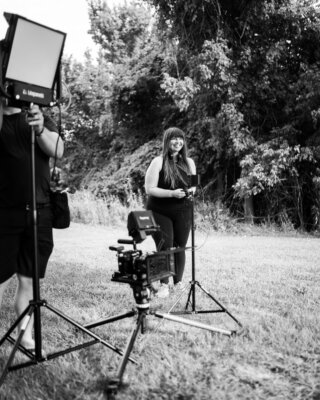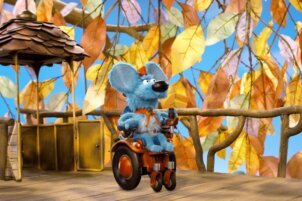By Maureen McEly, RespectAbility Entertainment Lab Alum

Maureen McEly on the set of her short film Golden Hour
When I became disabled in 2020, I dealt with a strange side effect: my ambition increased. Previously, I’d been content as a writer, but suddenly, despite struggling to adjust to my new physical limitations, I grew obsessed with the idea of telling my own stories every step of the way, and I decided I wanted to become a director as well. However, living with a neuromuscular disease that causes strength and stamina issues as well as muscle weakness and fatigue, I found myself intimidated by the physical aspect of directing and I feared this new dream of mine might be out of reach. But when I was selected for the RespectAbility Entertainment Lab, I encountered other disabled creatives carving out a path in filmmaking with disability accommodations at the very center of their work. I was so inspired, I took the leap and directed my first short film, Golden Hour, which was completed earlier this year. As I reflect on the film and the filmmaking experience, while going through the process of submitting to festivals, I thought it might be helpful to share what I learned writing, directing, and producing my first short film with a disability, in hopes it might be useful for other aspiring disabled directors.
1) It starts with the script.
Choose, or write, the script you plan to direct with your disability in mind. Every disability is different and so are the accommodations you’ll need while directing, so it’s helpful to choose a project that you think will work best with your particular disability, especially if it’s your first time directing and you’re not sure how things will go. For me, with my neuromuscular disease, I knew I didn’t want to overexert myself with multiple long days – or weeks – of filming. So, when writing the script, I decided I wanted to tell a complete story in just five pages, to ensure the shooting schedule would be something I knew I could achieve within my physical limitations. Whether you’re writing the script yourself, or choosing from projects written by other people, think about the story you want to tell and how best it would work for you and your disability while it’s still on the page – it’s easier to make changes there than when you’re filming!
2) Tell key crew members about your disability and any accommodations you’ll need from the beginning.
The plan for your accommodations needs to be built into the plan to shoot. From the very first conversation with the very first person I hired for my crew, I was clear about my disability and the accommodations I would need as a director, because it all needed to be part of constructing the filming game plan. For instance, I have to stop to take medication for muscle strength every four hours, and I have difficulty with stairs and steep inclines. I’m also immunocompromised, so I wanted to hire crew members who were willing to mask indoors. It was important for me to know ahead of time that I’d have people who would work with all of my needs, and it also was key for them to understand all of the variables when proposing ideas for the schedule, or locations, or the shot list. Filmmaking is a logistical puzzle. Your key crew members need to be aware of all the pieces so they can work with you as a team to put them together.
3) Create a tailor made filming schedule that works for you and your disability.
Your shoot day does not have to be 12 hours long. The moment I knew I might be able to actually handle the physicality of directing a short film is when I saw a shooting schedule from a filmmaker in my RespectAbility Lab cohort: not only was the schedule NOT the standard 12-hour day, but the entire plan also was built with disability accommodations as the guiding principle. No exaggeration: seeing that shooting schedule changed the trajectory of my creative life. What I previously worried might be impossible for me – physically getting thorough a long shoot day on set – suddenly seemed achievable. I realized, as a director, I could make the schedule whatever I needed it to be in order to work with my physical needs. What I ended up doing for my short film was creating a schedule that split what could have been one long day of filming into two short days of just about four hours each, which worked much better for me, especially since I wanted this experience to be a testing ground to see how I would handle the physical aspect of directing in terms of stamina and strength.
4) Think about accessibility in your locations.
Choose where you shoot wisely. With my neuromuscular disease, myasthenia gravis, I have trouble with elevation, particularly steep hills and multiple flights of stairs. I can do one moderate sized flight of stairs, but if there are multiple, or if there are repeated trips up and down one flight in a short amount of time, I have muscle weakness and fatigue issues that often wipe me out for hours or more. So, I made sure to choose a mostly flat outdoor location for the first day of filming, and while we did have to shoot one scene up a flight of stairs on the second day, I planned ahead so that once I was upstairs, I stayed there until we finished that scene. One way to make sure locations work for you is to be present at all location scouts, or to at least request a detailed video of each location if attending in person isn’t possible. Also, be sure to ask your crew members if they have any mobility or other accommodation related issues themselves. A set that’s accessible for everyone should be the goal.
5) Know when you can push and when you can’t.
Getting the shot is important, but not at the cost of serious risks to your health. Being ambitious as a director, but also having a disability that can become dangerously worse with overexertion, thinking ahead about exactly how far I could push myself physically, was the most crucial aspect of planning. Filmmaking is unpredictable and all sorts of problems and delays can arise in the moment. It’s vital to know the things you can – and can’t – be flexible about when trying to make your days. For example, in ideal situations, I try to sit still for about 10 minutes both prior to and after taking my medication, because those are my physically weakest moments and exertion during those times can reduce my strength for the rest of the day. However, since I built a shoot day that ended right as my medication was needed, I was able to take my dose without resting when we needed to film longer than planned, because we would soon be wrapping for the day and I would have hours (and a whole night of sleep) to rest and recover. But if I’d needed to push like that at the beginning of the shoot day, I would have had to make a different decision, like directing from a monitor while resting in the car instead of standing up on set. So, think about any issues you might have in advance, especially if schedules might change, which they often do, on the fly, during filming, and know ahead of time which ways you can – and cannot – go with the flow.
6) Have plans (and back up plans) for all your disability needs.
Make a list of everything you need to bring with you to set and build in redundancies. A fun fact about me is that I am deeply addicted to chapstick, to the point I am never in a situation where I’m without it: I have purse chapstick, car chapstick, desk chapstick and (many) more. This was actually helpful to me because it informed the way I operated with my medication on set. I had some in my backpack, I had some in my car, I had some in my pocket, just to make sure I wasn’t ever caught without it when I needed it and there would be no delay in taking it. But my planning (and back up planning) didn’t stop at medication: my illness is exacerbated by heat, and we ended up filming one scene outdoors in August. I thought I’d be okay because filming took place in early evening instead of the hottest part of the day, but in case I wasn’t, I made sure my car could be parked close enough to set that I could take breaks in the air conditioning if needed, and I also made sure to have plenty of ice and water on hand to cool myself off. Think about everything you might need, from medication, to mobility devices and more, and have back up plans – and back up plans for your backup plans.
Now, despite what I anticipated correctly and the everything that went right, there are a couple of things I would have done differently, looking back, and I want to share those as well:
1) Don’t spread yourself too thin.
When keeping the budget in mind, don’t cut anything that might hurt you as far as your disability accommodations. With my short, due to the tight financial constraints and my years of producing experience, I was not only the writer and director, I was the producer too. I figured this would be fine because we had a PA to help with physical things, like carrying craft services, holding an umbrella to shield our actresses from the hot August sun so they didn’t burn, and any other things that might come up. But, again: when making movies, things go wrong. We had an issue with our location that required our PA to leave set for a long period of time, so some physical tasks fell to me because I was the only person there who was not running a camera or sound. In retrospect, it would have been better to hire a producer, or at least to hire a second PA, to make sure I always had some help for physical tasks.
2) Research the film festival circuit in depth ahead of time.
It’s a complex environment and very expensive: plan ahead to maximize your money and time. I was so excited about directing a short film I didn’t think too deeply about the film festival world until afterwards, which was a mistake because there are so many film festivals it can take quite some time to figure out where your film might fit. And in the time it takes to research that, you may miss deadlines and also lose out on discounts in pricing by not applying as early as possible. Also, if you’re dealing with a small budget, the process of submitting to film festivals might be very slow since you’ll only be able to afford to apply to one or two at a time and it takes months to hear back: I didn’t fully understand how slow it could be! Extreme patience is required. On the upside, in my research, I did discover that some festivals offer discounted or free submissions for disabled filmmakers, so always double check the details section of a festival’s Film Freeway page or website when submitting – or email asking about waivers for disabled filmmakers.
3) Consider making a disability centered film.
There are a growing number of festivals for disabled creatives, but most want stories specifically about disability. From ReelAbilities to Over the Rhine, to Superfest and the Unstoppable section of the Slamdance Film Festival, there are many amazing outlets focused on work from disabled filmmakers. But your work may not be a great fit – or, in some cases, even eligible – if it is not focused on disability or the disabled lens in some way. My own short film is a sci-fi/drama that’s a proof of concept for my Nicholl quarterfinalist feature screenplay. That feature script does have a disabled protagonist, but in the short, there is no indication of her (nonapparent) disability and it’s not part of the short film at all, so it doesn’t qualify for many of the wonderful disability-centered film festivals out there. In hindsight, since it is so difficult to research and then break into the film festival circuit, I think it makes more sense, as a disabled filmmaker, to make at least your first short film centered around disability in some way in order to have a clear starting point as far as where to submit your work and to begin the process of building a network and community of connections with film festival programmers and other disabled filmmakers.
As I look back at my first time directing, the things I am proud of, and the experiences that will help me grow and improve in my next directing endeavor, my final and most important piece of advice is: GO FOR IT. Directing a film is an accomplishment. It’s a piece of creative work you can take pride in and it’s something that shows the world what you can do as a filmmaker. Disabled people are vastly underrepresented in filmmaking, in front of and behind the camera, and we desperately need more disabled directors out here making our own films – both to create disability centric projects that tell our specific stories from our own perspectives, but also to direct anything and everything that lives in our minds and hearts as creative people. No matter what your disability and accommodation needs, I believe there is a project, a schedule, and an accommodation plan that can bring your specific and unique vision to life – I can’t wait to see it.
Maureen McEly is a writer, director, and producer based in the Midwest. She spent more than a decade in the unscripted world, producing episodes of television for networks like Bravo, MTV, and NBC before leaving that field to pursue her own creative work. Since then, she’s been in the finals or semifinals in the PAGE, Nicholl, Slamdance, and American Zoetrope screenwriting competitions, and has directed her first short film. She’s an alum of the RespectAbility Entertainment Lab and has a degree in Film & Television Production from the University of Southern California.






